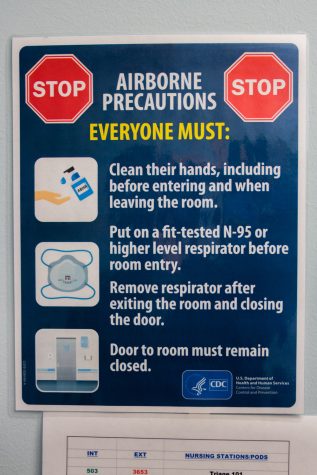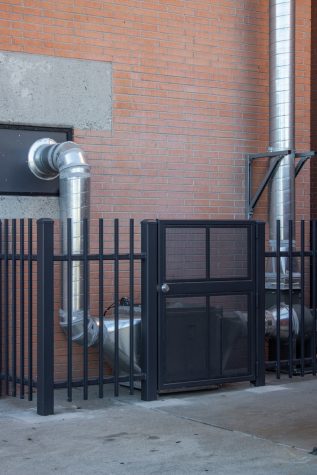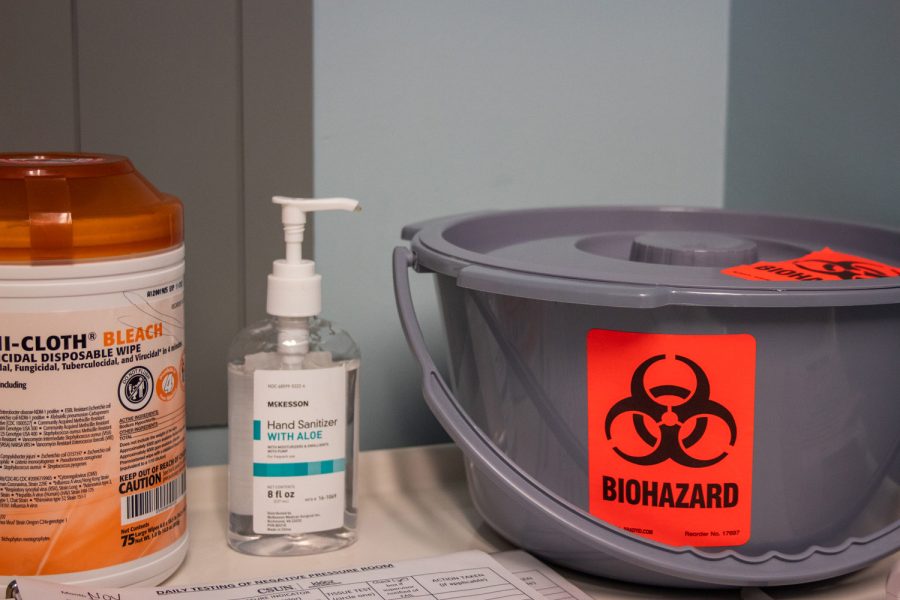Klotz Center combats COVID-19 on campus with new negative-pressure room
November 5, 2021
The Klotz Student Health Center’s 150 square-foot negative-pressure room is the first of its kind in the California State University system, and it has become an important part of ensuring the safety of students, faculty and staff during the pandemic.
Used to quarantine someone who is infected with an airborne pathogen such as COVID-19, the single-occupancy isolation room keeps the air inside the room clean with controlled venting only. This approach has been used in hospitals and medical centers to prevent cross-contamination and it protects people outside of the room from exposure.
Out of the 23 CSU campuses, CSUN is one of the first to build an Air Infection Isolation Room in their medical building on campus, according to interim director of Environmental Health and Safety Daniel Castellón.

Also known as an AIIR, this type of single-patient room prevents the infected air from drifting into other rooms and pushes it outside of the building through a high-efficiency particulate air filter that captures the harmful air particles before they can be released into the environment. The Centers for Disease Control recommends this as a way to prevent infection when dealing with a suspected or confirmed COVID case.
While most individuals will self-isolate at home or visit an outside medical provider if they experience COVID-19 symptoms, the negative-pressure room gives the Klotz Center a better chance at reducing the spread of the virus if a symptomatic patient enters their building.
“It’s really a way that we can take one more step to help students stay safe and not pass on the virus to others,” said Dr. Linda Chassiakos, director of the Klotz Student Health Center.
Finding solutions to reduce the spread of COVID-19 on campus was assigned to the Klotz Center, the Facilities Planning, Design and Construction Services, and the Environmental Health and Safety department.
The Facilities Planning Services took the lead on this project last year by overseeing the hiring of an independent engineering company to work on the pressure room. EHS was brought in around October 2020 to check the completed projects and ensure they worked properly.
Hand washing and wearing masks works to prevent spreading the virus, but how to care for students, faculty and staff who were already infected presented a new challenge for Chassiakos, Castellón and the Facilities Planning team.
Their solution was hiring an independent contractor to design and build a negative-pressure room to hold possible COVID patients.
The addition of a negative-pressure room means members of the CSUN community have better access to receiving care if they become infected with the virus. Faculty, staff, students living in Student Housing and those who reside off campus can report to the Klotz Center if they experience COVID symptoms and be taken to the negative-pressure room.

The patient will first be held in the negative-pressure room for a few hours depending on the severity of their symptoms, limiting exposure to other visitors at the center. Shortly after, the patient will be released with self-isolation orders or referred out to another medical facility to get more round-the-clock care that the Klotz Center cannot provide.
Renovations to the room, which was once used as a regular checkup area, occurred last year and it opened to the campus community in January. Some of the new features include the filtration system that pushes air from the first-floor room out to the roof of the Klotz Center and a connecting area where nurses can put on and get rid of their personal protective equipment. The changes were significant, but they were all contained within the existing space.
The negative-pressure room is now a permanent fixture in the Klotz Center due to its ability to address other airborne diseases as well, according to Castellón.
Alongside building the negative-pressure room, EHS also worked on replacing the air filters in multiple buildings across campus with the high efficiency particulate air filters that are said to capture air droplets better than others, according to the American Society of Heating, Refrigerating and Air-Conditioning Engineers.
Castellón said that the other CSU schools did not initially understand why he and the Physical Plant Management team went to such lengths. After the structures were completed, he began receiving calls from them asking for the engineering firm’s contact information.
“Sometimes it’s hard being the first,” Castellón said. “But we thought we were forward-thinking and said, ‘You know what? This is gonna be the best thing for the campus.’”
